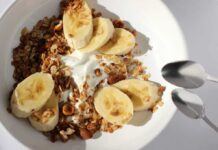
Your gut health plays a vital role in your skin’s appearance, and what you eat directly impacts how your complexion looks and feels.
At a Glance
- Research shows a strong connection between gut microbiome and skin conditions like rosacea and inflammation
- Probiotic-rich foods like yogurt, kimchi, and kombucha can improve both gut and skin health
- Protein consumption from sources like salmon, eggs, and plant-based options supports skin structure and repair
- An estimated 16 million Americans suffer from rosacea, which can be triggered by diet
- Experts recommend prebiotic foods including fruits, legumes, and leafy greens to support beneficial gut bacteria
The Gut-Skin Axis: Understanding the Connection
The relationship between gut health and skin appearance is becoming increasingly clear to dermatologists and researchers. This connection, often called the gut-skin axis, explains why digestive issues frequently manifest as skin problems. When your gut microbiome is imbalanced, it can trigger inflammatory responses throughout your body, including your skin. This inflammation may present as redness, acne, rosacea flares, or accelerated aging. For those over 40, maintaining this delicate balance becomes even more crucial as both digestive and skin systems naturally experience changes with age.
Rosacea serves as a prime example of this gut-skin relationship. This chronic inflammatory condition affects an estimated 16 million Americans, causing facial redness and flushing. While genetics play a role, emerging research points to the gut microbiome as a significant factor. Probiotics may benefit rosacea by improving gut health, as the condition appears linked to the microbiome of the gastrointestinal tract. Common triggers include spicy foods, alcohol, hot beverages, stress, hormonal changes, and temperature extremes – many of which also impact digestive function.
Probiotic Foods for Skin Health
Incorporating probiotic-rich foods into your diet is one of the most effective strategies for improving both gut and skin health simultaneously. These foods contain beneficial bacteria that help balance your microbiome. Top choices include fermented foods like kimchi, kombucha, kefir, miso, fermented pickles, sauerkraut, and tempeh. Raw apple cider vinegar and yogurt with active cultures also deliver probiotics. These foods help regulate your gut flora, potentially reducing inflammation throughout your body, including your skin.
To maximize the benefits of probiotics, you need to feed them with prebiotics – special plant fibers that nourish beneficial bacteria. Prebiotic foods include fruits like apples, berries, and bananas; legumes like beans and lentils; nuts and seeds; and vegetables including asparagus, artichokes, garlic, onions, and leafy greens. This combination of pro- and prebiotics creates a synbiotic effect that helps optimize gut function and, by extension, skin health and appearance.
Protein: The Building Block for Skin Structure
Protein plays a critical role in maintaining skin health, especially as we age and natural collagen production declines. According to dermatologists and dietitians, protein-rich diets support healthy, glowing skin by providing the amino acids needed for cell repair and regeneration. The best animal-based proteins for skin health include salmon, which delivers both protein and essential omega-3 fatty acids that fight inflammation, along with eggs and plain Greek yogurt, which offer complete proteins without added sugars or artificial ingredients.
Plant-based protein sources also offer excellent skin benefits. Almonds, tofu, lentils, goji berries, walnuts, and hemp seeds all provide protein along with various micronutrients and antioxidants that support skin health. These foods contain compounds that fight oxidative stress and provide the building blocks for collagen and elastin formation. For those over 40, increasing protein intake becomes especially important as protein absorption efficiency naturally decreases with age, potentially affecting skin’s resilience and healing capacity.
Protecting Your Skin from the Inside Out
While topical skin care remains important, nourishing your skin from within offers deeper, more sustainable results. Diet affects everything from hydration levels to inflammation responses that manifest on your skin. Staying well-hydrated is essential for skin elasticity and barrier function. Antioxidant-rich foods like berries, dark chocolate, and green tea help combat free radical damage that accelerates aging. Omega-3 fatty acids from fish, flaxseeds, and walnuts reduce inflammation that can trigger conditions like eczema and psoriasis.
Equally important is identifying and avoiding foods that may trigger individual skin reactions. Common culprits include high-glycemic foods that spike blood sugar levels, potentially worsening acne; dairy products that may influence hormone levels; and highly processed foods containing artificial ingredients that can promote inflammation. By observing how your skin responds to different foods and making appropriate adjustments, you can develop a personalized eating plan that supports both gut health and skin vitality for years to come.


















